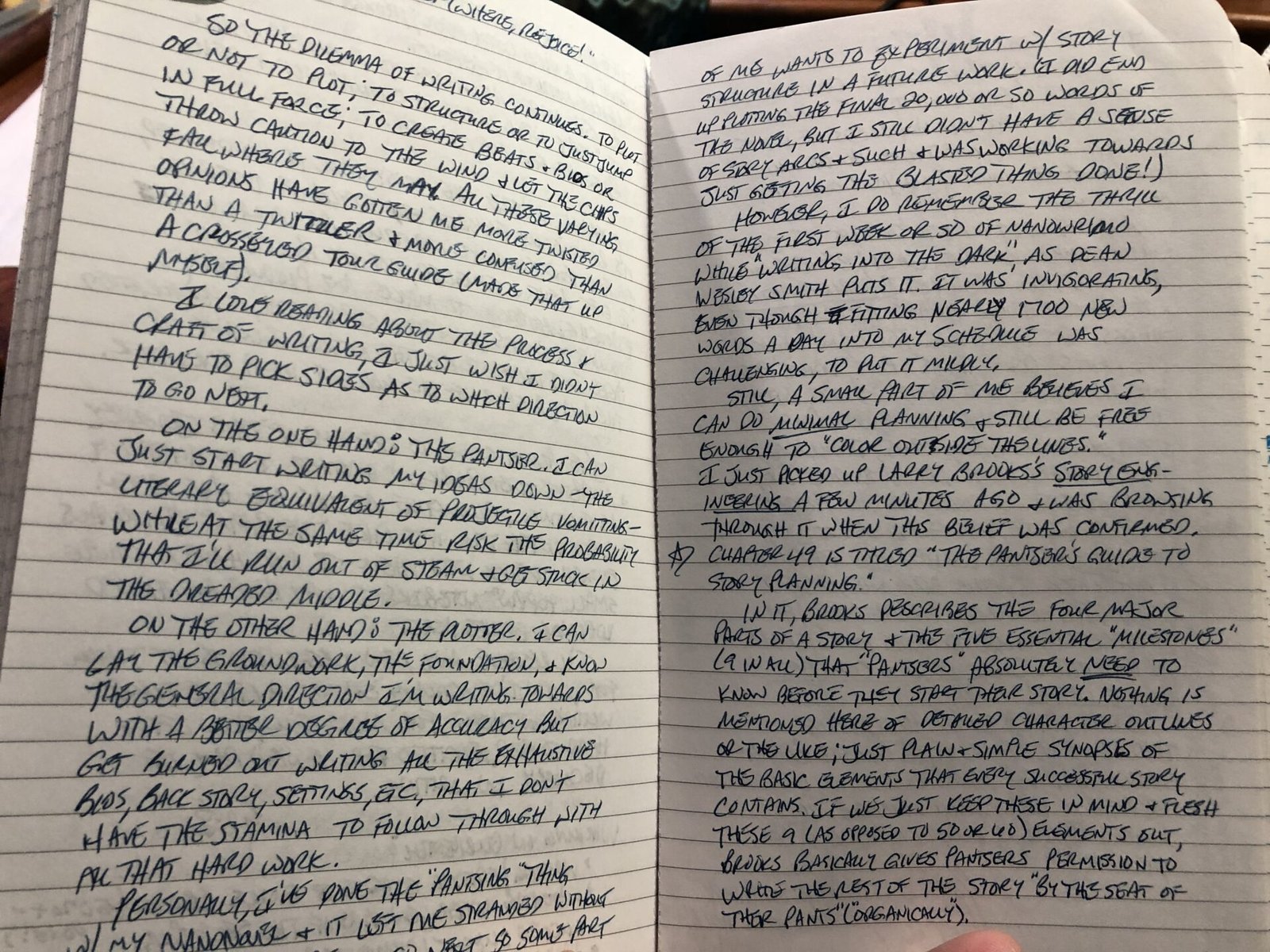Have you ever wondered whether to plot a novel or just write by the seat of your pants? Join me as I discuss this age-old writing dilemma.
More...

Excerpted from my lagoon blue “Ecosystems” journal on July 22, 2015.
The Age-Old Writing Dilemma
So the age-old writing dilemma continues. To plot (aka “Plotter”) or not to plot (aka “Pantser”).* To structure or to just jump in full force. To create “beats” and character bios or throw caution to the wind and let the chips fall where they may.
All these varying opinions have gotten me more twisted than a Twizzler and more confused than a crosseyed tour guide. (Made that one up myself). I love reading about the process and craft of writing. I just wish I didn’t have to pick sides as to which direction to go next.
*Fun Fact: Combine the two and you get a “Plantser.”
On the One Hand: The Pantser
I can just start writing my ideas down—the literary equivalent of projectile vomiting—while at the same time risk the probability that I’ll run out of steam and get stuck in the dreaded middle.
On the Other Hand: The Plotter
I can lay the groundwork, the foundation, and know the general direction I’m writing towards with a better degree of accuracy. But I risk getting burned out writing all the exhaustive bios, backstory, settings, etc. Then take a chance that I won’t have the stamina to follow through with all that hard work.
My Personal Experience Pantsing a Novel
Personally, I’ve done the “pantsing” thing with my first novel, and it left me stranded without a clue as to where to go next. So some part of me wants to experiment with story structure in a future work. I did end up plotting the final 20,000 or so words of the novel, but I still didn’t have a sense of story arcs and such. (Besides, I was working toward just getting the blasted thing done!)
However, I do remember the thrill of the first week or so of NaNoWriMo while “Writing Into the Dark,” as Dean Wesley Smith puts it. It was invigorating—even though fitting nearly 1,700 new words a day into my schedule was challenging, to put it mildly.
Still, a small part of me believes I can do minimal planning and still be free enough to “color outside the lines.” I just picked up Larry Brooks’ Story Engineering a few minutes ago and was browsing through it when this belief was confirmed. Chapter 49 is titled “The Pantser’s Guide to Story Planning.”
The Pantsers’ Redemption
In Story Engineering, Brooks describes the four major parts of a story and the five essential “milestones” (nine in all) that pantsers absolutely need to know before they start their story. Nothing is mentioned here of detailed character outlines or the like; just plain and simple synopses of the basic elements that every successful story contains. If we just keep these in mind and flesh these nine (as opposed to fifty or sixty) elements out, Brooks basically gives pantsers permission to write the rest of the story “by the seat of their pants” (aka “organically”).
This is good to know.
Your Unique Way of Writing
But really, it all comes down to one simple fact: Every writer is unique. And while there may be hundreds of ways to craft a story, one thing holds true: You must find your own way of writing.
And the only way to do that is just write. Simple, but not easy; believe me, I know. This requires experimentation—and lots of it. And experimentation means trying new things. Try everything you can think of.
Pants; don’t pants. Plot; don’t plot. Use an outline; use beats. Start with just one line that describes your story; or work backwards, distilling your literary vomit down to one line, thus reverse engineering this process. (Similar to Randy Ingermanson's The Snowflake Method.)
Every writer is unique. And while there may be hundreds of ways to craft a story, one thing holds true: You must find your own way of writing.
- me
Taking the Next Steps
The bottom line: Just write for goodness’ sake. No, for your sake! Write now and figure it out later. There are no wasted words. It’s all grist for the mill; all practice, serving to hone your skills as a writer. Just do it and correct course later! [Do it scared if you have to, but just do it.]
Start with a small project or two. Find your own groove before setting out for more expansive, uncharted territory. And be of good courage. Your unique process is eagerly awaiting to be discovered.
P.S. Just a thought: No wasted words here!
Featured Resources
Please disable any adblockers to see certain resources below.
Let Payhip host your books, products, or services
Disclaimer: Some of the links on the page may be affiliate links. These links allow me a small commission on every sale at no extra cost to you. So if you'd like to show your support for my work, feel free to use the links on this page.

